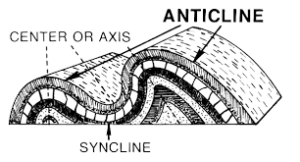What are anticlines and synclines?« Back to Questions List
|
Anticlines and synclines are the terms associated with the movement of earth. They are actually types of folds. A fold is a rock formation that has been made by flat rocks becoming deformed due to stress and pressure. Depending on how the layers of earth get folded, the folds are classified as anticlines and synclines. Structures formed by geological folding are found all over the earth, and can be of any size. Rocky Mountains of America, South America's Andes and Europe's Alps are all examples of mountains that have been formed by folding. Folds form under varied conditions of stress, pressure and temperature. Folds are classified by their size, fold shape and tightness. The amount of force per unit of area on a substance is stress. Change in a rock’s shape due to stress is called deformation. The stress that squeezes rocks together is compression. Stress that stretches rocks is called tension.
Bends that form in rocks due to stress are folds. Folds can be as large as mountains or as small as centimeters. The two most common types of folds are anticlines and synclines. Upward folds like arches are called anticlines. In an anticline, a fold arches away from the earth. The top of the arch is called the crest of the anticline. In an anticline, the oldest rocks are at its core, or center. Synclines are downward folds like troughs. In a syncline, the fold bends down towards the earth. Synclines have their newer rocks at their centers and older rocks at the outsides. Basins are the depressions formed by synclines.
Why don’t we feel the rotation of earth?What lies under the surface of earth? |

